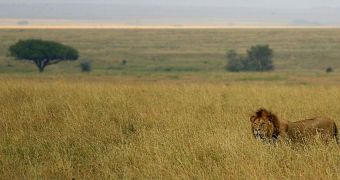According to a new scientific study, it would appear that short-term weather and temperature variations have a wider range of effects on ecosystems and the species they contain, than slower shifts in global climate. This makes sense from an evolutionary point of view, experts say, as a slower, more gradual shift would provide both plants and animals with sufficient time to adapt to the new conditions, over several generations. When shorter term changes occur, the chance for all living things to evolve in the face of the new challenge is diminished, as many more die after the modifications to their ecosystems take place, PhysOrg reports.
It's also worth noting that the research seems to have deep roots in our planet's ancient history. All five major extinction events that threatened or killed the vast majority of life forms on the planet were sudden events. They took place either when an asteroid or a comet struck the Earth, and drastically changed the temperature ranges and atmospheric composition the animals and plants of the time were accustomed to, or when volcanoes and earthquakes did the same. Still, the common element they share is that they were sudden events, which did not give animals and plants sufficient time to adapt. Those that did not do so died soon after the initial calamity.
Researchers say that the whole climate-variation thing is a two-bladed sword. For one, it can have the dramatic effect of eliminating all species (animals and plants alike) that are only adapted to a narrow range of temperatures, or other similar factors in their ecosystems. According to estimates, thousands of species may fall under this category, experts say. On the other hand, such temperature variations, recorded over short periods of time, could also prevent dominant species from killing off all their competitors, and establishing a strong foothold in a certain ecosystem. If this is avoided, then evolution can accelerate, and the other, surviving creatures have a higher chance of adapting to the new conditions as well
“Imagine species that have different optimal temperatures for growth. In a fluctuating world, neither can get the upper hand and the two coexist,” the leader of the new research project, University of California in San Diego (UCSD) ecologist Jonathan Shurin, explains. He and his team published the details of their idea in the January 21 issue of the respected scientific journal Ecology Letters. The pace and range of environmental variability could have a direct influence on whether biodiversity is lost or gained.
“It may depend on the predictability of the environment. If you have a lot of violent changes through time, species may not be able to program their life cycles to be active when conditions are right. They need the ability to read the cues, to hatch out at the right time. If the environment is very unpredictable, that may be bad for diversity, because many species just won't be able to match their lifecycles to that,” Shurin says.
The team also discovered that fluctuations in the chemical composition of ecosystems were also more likely to promote reductions in population sizes than temperature variations. This was found to be especially true for lakes, where changes in temperatures promoted biodiversity to a great extent.
“Patterns of association between diversity and environmental stability indicate that increasing frequency of extreme events and greater ranges of variability may be as or more important than changes in average conditions as drivers of […] community diversity,” the experts wrote in their study. “Our results also raise concern about the future of lake biodiversity in a changing global environment. Increasingly variable and unpredictable conditions have been observed and are forecasted (sic) to continue by many climate models,” they conclude.

 14 DAY TRIAL //
14 DAY TRIAL //